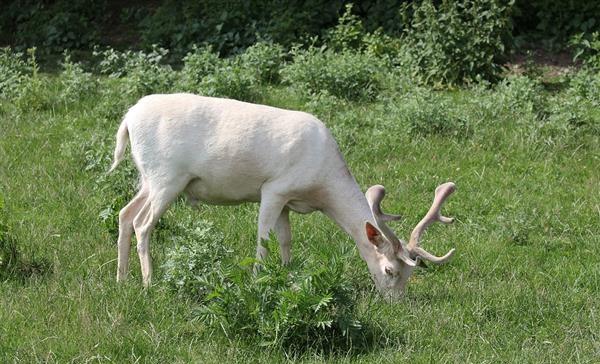In traditional Chinese culture, the white deer is a symbol of auspiciousness, happiness and longevity. In early October this year, the news of British resident Max's encounter with a white deer in London's "bush park" attracted the attention of many animal lovers. What species is this white deer? How precious is it?
Max's White Hart Bush Park covers an area of about 4.5 square kilometres and is the second largest Royal Park in London. Open to the public, there is also a nature reserve that preserves a variety of wildlife, including tiān deer and red deer. The white deer max saw was one of the moose.

Infographic
The name "Moose" may not be familiar to some people. This deer does not have a natural distribution in China, but is native to the surrounding mediterranean region of Europe. As a highly adaptable deer, the moose can survive in a variety of environments such as forests, grasslands, and shrublands.
In modern times, humans have introduced them to the world as hunting animals and ornamental animals. For example, the British mole deer were mainly introduced by the Normans around the 11th century.
Today, with the exception of Antarctica, deer can be found on every continent in the world.
Herds of moose with significant differences in individual coat color Source: arkive
The English name for a moose is "fallow deer", which means light yellow here, but not all deer fur is pale yellow.
In the deer kingdom, the moose is known for its rich "body color variant". Their coat color can be broadly divided into four categories: light yellow, maroon yellow, black (melanistic) and white (leucism). Sometimes several deer with different coat colors can be seen in a deer herd. Although the coat color is different, the deer are still the same species.
Pale yellow fur is more common. The summer hair of these deer has white spots, and the winter hair is generally brownish gray with no spots, while the maroon fur of the deer, whether summer hair or winter hair, has spots on it.
In recent years, some zoos in China have also introduced deer, but tourists see the above two types of coat color of the deer, often confuse them with sika deer.
In fact, it is very simple to distinguish between a deer and a sika deer, the first look at the size, the shoulder height of adult deer is less than 1 meter, and the shoulder height of adult sika deer is about 1.3 meters.
The second look at the horns of the stag, the horns of the deer are "palm horns", and the horn branches form connected bone plates. The sika deer is a branch-like horn, and the horns are as well-rooted as branches.
Comparison of a deer (left) and a sika deer (right) Source: Wikipedia
The black variant of the moose is relatively small in number. Their fur is not black, but a dull dark brown. The white variant of the deer, the type Max saw in Bush Park, was even rarer than the black variant. As adults, they are snow-white and spotless, and their eyes are generally brownish-black instead of blood-red.
The white variant of the moose does not suffer from "albinism". In simple terms, albinism is caused by the body's inability to synthesize "tyrosinase" normally, which in turn prevents pigment cells from synthesizing melanin normally. The white variant is produced due to problems in the development, differentiation or migration of "pigment cells" at the embryonic stage.
Even though the body's mechanism for producing melanin is normal, the fur appears white due to the lack of healthy pigment cells in areas such as the skin. As for the fact that the eye is not blood red, it is because the pigment cells in the iris and retinal areas are produced from different sources and are therefore less affected.
The Greek Silver Cup of the Fourth Century BC Source: Wikipedia
The influence of the moose on European culture is profound. It is one of the main hunting objects of ancient humans, and its beautiful and flexible image has also brought inexhaustible inspiration to the creation of works of art. Due to the large population and wide distribution range, the moose is currently a non-threatened species on the Red List of Threatened Species.
European countries such as the United Kingdom have listed the moose as a protected animal in the country. These countries control the number of deer under the premise of protection to avoid the damage caused by their overbreeding to agriculture and forestry. A combination of protection and control, which is currently the main management method for dowel in Europe.
Science popularization 100% helps science popularization in China, so that scientific knowledge becomes popular on the Internet and in life. Warm tips: The above is 100% popular science online reading browsing content, reprint sharing only for knowledge dissemination and learning publicity, the content of this article only represents the original author's views, if there are comments and suggestions, please leave a private message, we will deal with it in a timely manner. Welcome to the attention, thank you.